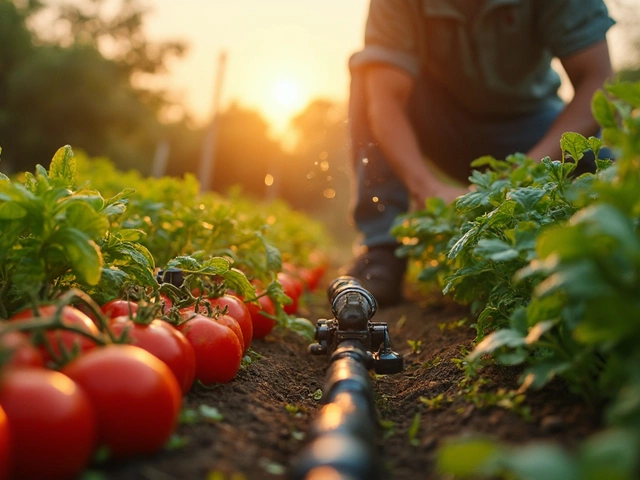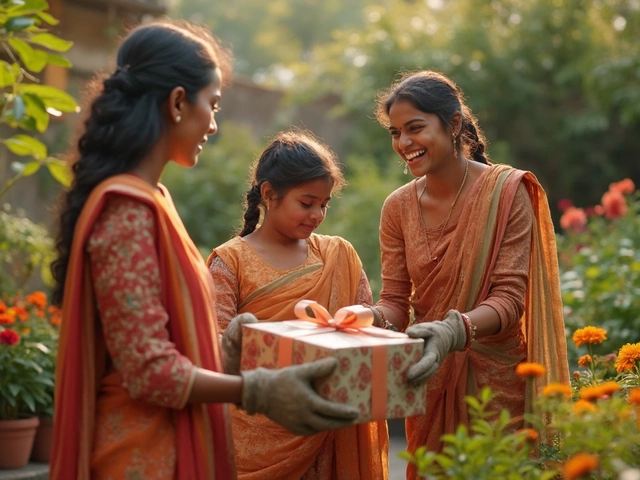Not every plant can handle the chaos of a rooftop garden. You're asking a plant to deal with blinding sunlight, gusty wind, blazing heat, and sometimes even freezing cold—all on a slab of concrete. Some folks get discouraged after their first fried fern or wilted tomato, but here’s the trick: pick the right plants, and you’re halfway to a cool, lush retreat in the sky.
First, figure out how much direct sun your spot gets, and if your building can take the extra weight of soil and pots. Lightweight soil mixes and shallow-rooted plants work great where load is a concern. If you can set up wind screens or shade cloth, that opens up more options. But even with harsh rooftop conditions, there are tough performers that just don’t quit.
Plants that do best on rooftops prefer lots of sun, shrug off dry spells, and don’t mind a bit of wind. Succulents, herbs, and dwarf trees lead the pack. Most people are surprised that Mediterranean favorites—like lavender, rosemary, and thyme—not only survive, they actually look better up there. These guys are built for rough living, and their scent gives city gardens serious character.
- What Makes Rooftop Gardening Unique?
- Toughest Decorative Plants for Rooftops
- Edibles that Love Rooftop Sun
- Cool Climbers and Vines
- Containers, Soil, and Watering—What Works?
- Pro Tips for Rooftop Success
What Makes Rooftop Gardening Unique?
Rooftop gardening isn’t your run-of-the-mill backyard project. The conditions on a roof are way tougher and way different from what you get at ground level. For starters, the sun just bakes everything—without trees or fences to give shade, your plants are exposed for hours. Combine that sun with strong winds, and some days you’ll feel like you’re gardening in the middle of a desert.
Weight matters, too. Unlike regular yards, rooftops can’t always handle heavy pots, thick soil, or big trees. Most city rooftops are built to support only a certain extra weight—usually about 50 to 100 pounds per square foot. That means you’ve got to be careful with how much dirt, water, and material you bring up there.
Plus, water drains fast on most roofs, so soil dries out much quicker than in the ground. If you forget to water a day or two, your best tomato plant can turn crispy in no time. On windy days, those pots can even tip or blow over. You also see way more temperature swings—hotter in summer, colder in winter—compared to ground gardens. A rooftop can easily be 10°F hotter than the street below on a sunny day.
- Non-stop sun with little shade means selecting plants that love full sun is key.
- Fast drainage and shallow soil requires drought-tolerant and shallow-rooted species.
- Strong winds can damage fragile stems, so you need sturdy plants and windbreaks.
- Weight limits force you to pick lighter containers and soil mixes.
| Rooftop Factor | Challenge | Workaround |
|---|---|---|
| Full Sun | Overheating, scorched leaves | Use sun-loving, Mediterranean plants |
| Weight Limits | Roof stress, less soil depth | Lighter pots, compost-rich mixes, avoid big trees |
| Wind | Broken stems, tipped pots | Heavy pots on bottom, wind screens |
| Water Loss | Dry soil, thirsty plants | Mulch, self-watering pots, hardy plants |
This is why choosing the right rooftop garden plants is so important. Ignore the roof rules, and you'll be frustrated. Pick smart, and you get a chill green getaway above the city level.
Toughest Decorative Plants for Rooftops
When it comes to picking plants that don’t blink at rooftop weather, your best bet is to go for tough, drought-loving types. Mother Nature already tested these in wild conditions, so they’re perfectly built for city rooftop life. Let’s look at the heavyweights that can really handle the heat, wind, and root-restricted containers.
- Succulents: Sedum, echeveria, and sempervivum don’t mind baking all day. They store water in their leaves, laugh off poor soil, and basically run on autopilot.
- Lavender: Loves full sun, gives you beautiful purple flowers and smells awesome. Once it’s established, you barely have to water it.
- Rosemary: Not just for cooking—rosemary shrubs give a Mediterranean vibe and handle rooftop stress well.
- Ornamental grasses: Blue fescue, feather reed grass, and fountain grass look breezy and modern. They sway in the wind, but don’t fall apart or turn crispy.
- Creeping Jenny and ice plant: These spread out quickly in containers, provide a lush look, and bounce back after dry spells.
- Yarrow and coreopsis: These are sun-lovers. They bloom for months, attract pollinators, and basically grow on neglect.
Here’s a comparison of how some top decorative rooftop plants stack up:
| Plant Name | Sunlight Needs | Watering | Height | Best Feature |
|---|---|---|---|---|
| Sedum (Stonecrop) | 6-8 hours/day | Low | 15-45 cm | Low maintenance |
| Lavender | Full sun | Low | 40-60 cm | Fragrance & pollinators |
| Ornamental Grasses | Full sun/partial shade | Low-medium | 30-120 cm | Movement in wind |
| Ice Plant | Full sun | Low | 10-15 cm | Colorful groundcover |
| Coreopsis | Full sun | Medium | 40-90 cm | Long blooming |
Most of these can handle being in smaller pots, and don’t mind if you forget to water for a few days. For rooftop flair, mix grasses and succulents together—you’ll get texture, color, and zero drama. Always use pots with drainage holes and go for a lightweight soil mix to keep your rooftop garden easy to manage.
Edibles that Love Rooftop Sun
If you’ve got strong sunlight up on your roof, you’re sitting on prime real estate for growing killer veggies and herbs. Most edible plants love a full day of sun—think 6 to 8 hours or more. The trick is picking tough types that actually like it hot and dry. They grow faster, taste better, and make your rooftop garden pop with color you can eat.
Here’s the deal: fruiting crops like tomatoes, peppers, and eggplant are born for sunny, open spaces. Tomatoes in particular go wild in rooftop containers, since dry breezes keep leaf diseases down. Cherry tomatoes are the easiest and most forgiving—you’ll get sweet little bursts of flavor all summer, even with some neglect.
Don't skip hot peppers—jalapeños or cayenne will thrive and barely flinch during a dry spell. Herbs like basil, oregano, sage, and chives laugh off harsh rooftop conditions and reward you with tons of fresh taste. Bonus: most of these attract pollinators, so your roof stays buzzing with life.
If salads are your thing, try arugula or cut-and-come-again lettuces in partial shade, and spinach early in the season—just remember, lettuce does bolt if the heat gets too wild. Strawberries in hanging baskets or shallow trays also do great, plus they keep birds coming back.
- Tomatoes (especially cherry)
- Hot or sweet peppers
- Eggplant
- Herbs: basil, rosemary, thyme, oregano, chives, sage
- Arugula, lettuce, baby spinach (preferably with some afternoon shade)
- Strawberries (in containers or hanging baskets)
Rooftop veggies need a little help holding onto water. Go for bigger pots—at least 12 inches deep for tomatoes and peppers—and mulch the top to lock in moisture. Water deeply early in the day, but don’t drown them. Most herbs, especially rosemary and thyme, pretty much prefer things a bit dry anyway.
Check out this quick data table on popular rooftop edibles and their sun requirements:
| Plant | Sunlight Needed | Container Depth | Watering Needs |
|---|---|---|---|
| Tomatoes | Full sun (8+ hrs) | 12-18 inches | High |
| Peppers | Full sun (6-8 hrs) | 12 inches | Medium |
| Basil | Full sun (6+ hrs) | 6-8 inches | Medium |
| Rosemary | Full sun (6+ hrs) | 8 inches | Low |
| Arugula | Full sun/part shade | 6 inches | High |
| Strawberries | Full sun (6+ hrs) | 8 inches | Medium |
If you want a rooftop garden that feeds you all summer, stick with edibles that were made for heat and direct sunlight. Start simple and go from there—your salads and salsas will thank you.

Cool Climbers and Vines
Climbers and vines do wonders for a rooftop garden. They can quickly cover fences, railings, or ugly storage boxes with green, cool down the space, and even give a bit of privacy when you need it. Some grow super fast, while others are more chill and easy-going. What you pick depends on how much wind and sun your roof gets.
Here are a few rooftop classics that rarely let you down:
- Star Jasmine (Trachelospermum jasminoides): Grows thick, smells amazing, and handles city pollution well. Give it something to climb, and it's off to the races.
- Passionflower (Passiflora caerulea): Tough as nails and offers exotic flowers. Can even pop out some fruit if you’re lucky.
- Grapevine (Vitis vinifera): Not just pretty, but also gives real grapes by late summer if you give it enough sun and a strong support.
- Runner Beans or Beans (Phaseolus coccineus): If you want food and flowers, these guys look good and work hard. They really like heat.
- Boston Ivy (Parthenocissus tricuspidata): Sticks to almost anything and gives those wild red colors in fall. Really helps if you want total green coverage fast.
Worried about their roots? Vines tend to be fine in large, stable containers. Just make sure you keep the soil from drying out too much—water at the base to avoid crispy leaves.
Check out the table below for how these popular rooftop climbers stack up on sun, water, and wind tolerance:
| Plant | Sun Needs | Wind Tolerance | Water Needs | Special Perk |
|---|---|---|---|---|
| Star Jasmine | Full sun/Part shade | Good | Moderate | Strong scent |
| Passionflower | Full sun | High | Moderate | Unusual flowers |
| Grapevine | Full sun | Good | Low once established | Edible grapes |
| Runner Beans | Full sun | Medium | High | Edible beans + flowers |
| Boston Ivy | Full sun/Part shade | Very High | Low | Fall color |
One thing with vines: give them something sturdy to climb. Wire, trellis, or mesh—it doesn’t have to be fancy, just solid. Focus on tying them in early so the wind doesn’t snap new shoots. Keep an eye on watering during hot spells, but otherwise, these guys basically run themselves if you set up right.
Containers, Soil, and Watering—What Works?
Containers are a big deal on rooftops, and not just because of how they look. Choose sturdy, lightweight pots—plastic, fiberglass, or recycled grow bags all work. Avoid old-school terracotta unless you love dragging heavy planters around. Large containers are better for rooftop gardens because roots stay cooler and moist for longer. If you want less watering, go for a deep pot over a shallow tray.
Weight adds up fast. If you have a lot of plants, check your building’s load limit. Sometimes you’ll need to go smaller or stick to raised beds filled with lightweight mixes. Here’s a neat tip: use empty milk jugs or foam chunks at the bottom of big containers before filling with soil to cut down on weight.
Now, about soil—skip the dirt from your backyard. Regular garden soil gets heavy and hard as a brick when dry. Instead, use a potting mix, which is made to stay loose, drain well, and not weigh a ton. Add a little compost for extra nutrients and mix in perlite or expanded clay pebbles to help with drainage.
Watering is where most rooftop gardens go sideways. The wind and sun dry things out fast. A plant that looks happy in the morning can be flopping by dinner. Here are a few ways to keep your green crew happy:
- Use mulch on top of your soil to slow down evaporation. Even a thin layer of pebbles helps.
- Self-watering containers are worth the money, especially for busy folks or if your building has a watering ban.
- Skip the daily splash. Give plants a deep watering less often—roots grow deeper and get tougher this way.
- Morning is the best time to water; wet leaves overnight can lead to fungus.
Drip irrigation systems are a game changer if you have lots of pots or forget to water. Solar-powered timers work even if you’re renting and don’t want to deal with electrical cords.
| Type | Pros | Cons |
|---|---|---|
| Plastic Pots | Lightweight, cheap, keeps water better | Can crack in strong sun over years |
| Fiberglass | Modern look, lasts long, light | Pricier |
| Grow Bags | Super light, easy to move, roots breathe | Can wear out after a few years |
| Terracotta | Classic look, natural | Heavy, dries out fast |
Getting these basics right means your rooftop garden will actually thrive, not just survive. Once your plants are in the right container with healthy soil and a good watering plan, you’ll spend more time chilling on the terrace than hauling around a watering can.
Pro Tips for Rooftop Success
Getting your rooftop garden thriving isn’t just about picking pretty plants. It’s about smart planning and knowing what actually works when conditions get wild. Here's how you can save yourself a lot of headaches (and dead plants).
- rooftop garden soil dries out fast. Go for extra-large planters or raised beds so there's more space for moisture to hang around. Mix in water-holding stuff like coco coir or perlite to keep roots happy.
- Wind can shred delicate plants. Group your taller or tougher plants on the windy edge to shield smaller, fragile ones. If possible, add windbreak features—like trellises or mesh screens—on the sides taking the biggest hits.
- Use drip irrigation or soaker hoses. You'll waste a ton less water and avoid constant hand-watering in peak summer. Bonus: this also helps keep leaves dry, so you dodge a bunch of fungal problems.
- If your rooftop bakes all afternoon, try mixing in some light shade with umbrellas or even fabric left up with Velcro. Some herbs and leafy greens get crispy in full heat, so a bit of cover actually gets you better harvests.
- Don’t use garden soil from your yard—it's too heavy and can clog up rooftop drainage. Grab a lightweight potting mix made for containers.
- Arrange your pots so the tallest are at the back and smallest in front. This gives every plant sun, keeps things looking organized, and makes watering way easier.
Here’s a quick look at how different plant types handle typical rooftop conditions. Take a glance so you know what’s likely to survive in your space.
| Plant Type | Sun Tolerance | Wind Resistance | Water Needs |
|---|---|---|---|
| Succulents | High | Excellent | Low |
| Herbs (Rosemary, Thyme) | High | Good | Low to Medium |
| Lettuce & Leafy Greens | Medium | Poor | Medium to High |
| Dwarf Citrus Trees | High | Average | Medium |
| Ornamental Grasses | High | Excellent | Low |
One more thing—weight sneaks up fast on rooftops. Wet soil, big pots, and even water features add up. Always check your building's max load. If you’re unsure, go for more but lighter containers. Rooftop gardens can be fun, but safety first. Lastly, enjoy experimenting—some trial and error is normal! If something flops, switch it out and try again. City gardening rewards those who don’t give up easily.





